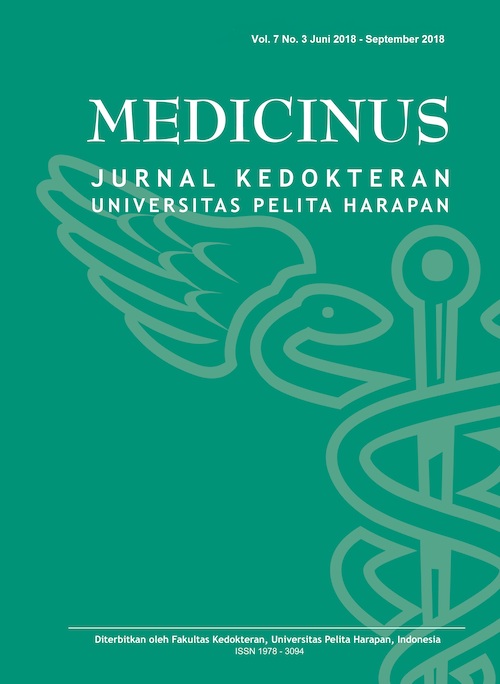Intradialytic Hypertension in End Stage Renal Disease patient : Prevalence and clinical characteristic
DOI:
https://doi.org/10.19166/med.v7i3.2293Keywords:
End Stage Renal Disease, Hemodialysis, Intradialytic HypertensionAbstract
Introduction : Intradialytic hypertension (IDH) is common and it increases the incidence of cardiovascular morbidity and mortality, however this is often ignored. The aim of this study is to identify the prevalence of IDH and compare the clinical characteristics of patients with and without IDH.
Methods : A cross sectional study was carried out in 3 hemodialysis clinics in Jakarta, Indonesia. We compared several clinical characteristics inpatients with IDH and control group without IDH. Nutritional status was also assessed using Subjective Global Assessment (SGA). IDH was defined as >10 mmHg increase in systolic blood pressure (BP) in at least four of six prior consecutive hemodialysis sessions. Student’s T-test or Mann-Whitney test was used to compare the quantitative variables. Chi-Square or Fischer exact test was used to compare categorical variables.
Results : A total of 114 patients was included in this study. There were 86 (62.3%) male patients. IDH was present in 47 (34.1%) patients. The mean age in IDH and control group were 53.4 (±13.2) and 52.8 (±12.4) years respectively (p: 0.800). The mean BMI of IDH and control group were 21.8 (±3.7) and 24.0 (±4.4) kg/m2 respectively (p: 0.031). The mean MAP during dialysis of IDH and control group were 108 (±13.1) and 98.6 (±23.2)mmHg respectively (p: 0.011). The median creatinine levels of IDH and control group were 8.1 (3.02-22.20)mg/dl and 10.8 (2.89-22.0)mg/dl respectively (p: 0.008). Interestingly, moderate to severe malnutrition status had significant association with IDH (OR: 2.31, p: 0.031). Patients who undergo dialysis thrice a week was associated with IDH rather than patients who undergo dialysis twice a week (OR: 2.27, p: 0.035).
Conclusion : The prevalence of IDH is higher than previously reported in other countries. The clinical characteristic of patients with IDH is lower BMI, higher MAP and lower creatinine levels than in patient without IDH. Moderate to severe malnutrition and frequency of dialysis per week had significant association with IDH.References
Geogianos PI, Sarafidis PA, Zoccafoli C. intradialysis hypertension in end stge renal disease patient. AHA journal. 2015; 66:456-463
Inrig JK.Intradialytic hypertension: a less-recognized cardiovascular complication of hemodialysis. Am J Kidney Dis. 2010; 55:580-589. doi: 10.1053/j.ajkd.2009.08.013
Inrig JK, Patel UD, Toto RD, Szczech LA. Association of blood pressure increases during hemodialysis with 2-year mortality in incident hemodialysis patients: a secondary analysis of the Dialysis Morbidity and Mortality Wave 2 Study. Am J Kidney Dis. 2009; 54:881- 890. doi: 10.1053/j.ajkd.2009.05.012
Inrig JK, Patel UD, Toto RD, Reddan DN, Himmelfarb J, Lindsay RM, Stivelman J, Winchester JF, Szczech LA. Decreased pulse pressure during hemodialysis is associated with improved 6-month outcomes. Kidney Int. 2009; 76:1098-1107. doi: 10.1038/ki.2009.340.
Raj DS, Vincent B, Simpson K, Sato E, Jones KL, Welbourne TC, Levi M, Shah V, Blandon P, Zager P, Robbins RA. Hemodynamic changes during hemodialysis: role of nitric oxide and endothelin. Kidney Int. 2002; 61:697-704. doi: 10.1046/j.1523-1755.2002.00150.
Cirit M, Akçiçek F, Terzioğlu E, Soydaş C, Ok E, Ozbaşli CF, Başçi A, Mees EJ.
Paradoxical rise in blood pressure during ultrafiltration in dialysis patients. Nephrol Dial Transplant. 1995; 10:1417-1420
Raikou VD, Kyriaki D. The association between intradialytic hypertension and metabolic disorders in end stage renal disease. Int journal of hypertension. 2018; 10:1155-64
Georgianos, P.I., Sarafidis, P.A., Zoccali, C. Intradialysis Hypertension in End-Stage Renal Disease Patients Clinical Epidemiology, Pathogenesis, and Treatment. Hypertension. 2015; 66: 456-463
Reddan, D.N., Szczech, L., Hasselblad, V., et al. Intradialytic Blood Volume Monitoring in Ambulatory Hemodialysis Patients: A Randomized Trial. Journal of the American Society of Nephrology. 2005; 16: 2162-2169.
Inrig, J.K., Patel, U.D., Toto, R.D., et al. Association of Blood Pressure Increases during Hemodialysis with 2-Year Mortality in Incident Hemodialysis Patients: A Secondary
Analysis of the Dialysis Morbidity and Mortality Wave 2 Study. American Journal of Kidney Diseases. 2009; 54: 881-890.
Losito, A., Del Vecchio, L., Del Rosso, G., et al. Postdialysis Hypertension: Associated Factors, Patient Profiles, and Cardiovascular Mortality. American Journal of Hypertension. 2016; 29: 684-689.
Inrig, J.K., Oddone, E.Z., Hasselblad, V., et al. Association of Intradialytic Blood Pressure Changes with Hospitalization and Mortality Rates in Prevalent ESRD Patients. Kidney International. 2007; 71: 454-461
Van Buren, P.N., Kim, C., Toto, R., et al. Intradialytic Hypertension and the Association with Interdialytic Ambulatory Blood Pressure. Clinical Journal of the American Society of Nephrolog. 2011; 6: 1684-1691.
F. Locatelli, S. Colzani, M. D'Amico, C. Manzoni, and S. Di Filippo. Dry weight and sodium balance. Seminars in Nephrology. 2001; 21(3): 291-297
S. Di Filippo, C. Manzoni, S. Andrulli, F. Tentori, and F. Locatelli. Sodium removal during pre-dilution haemofiltration. Nephrology Dialysis Transplantation. 2003;18: 31-36
Downloads
Additional Files
Published
How to Cite
Issue
Section
License
Copyright (c) 2020 Margaret Merlyn, Akhil Deepak Vatvani

This work is licensed under a Creative Commons Attribution-ShareAlike 4.0 International License.
Authors who publish with this journal agree to the following terms:
1) Authors retain copyright and grant the journal right of first publication with the work simultaneously licensed under a Creative Commons Attribution License (CC-BY-SA 4.0) that allows others to share the work with an acknowledgement of the work's authorship and initial publication in this journal.
2) Authors are able to enter into separate, additional contractual arrangements for the non-exclusive distribution of the journal's published version of the work (e.g., post it to an institutional repository or publish it in a book), with an acknowledgement of its initial publication in this journal.
3) Authors are permitted and encouraged to post their work online (e.g., in institutional repositories or on their website). The final published PDF should be used and bibliographic details that credit the publication in this journal should be included.





